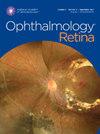Clinical Implications of Ultrasound-Based Morphology in Choroidal Melanoma
IF 4.4
Q1 OPHTHALMOLOGY
引用次数: 0
Abstract
Objective
To describe the frequency of different B-scan morphologies and their association with clinical features and outcomes.
Design
Cohort study of patients enrolled in the Prospective Ocular Tumor Study from January 2000 to January 2024 initially seen at Mayo Clinic Rochester.
Participants
Consecutive inclusion of patients with posterior uveal melanoma.
Methods
B-scan ultrasounds were performed by an experienced technician and treatment modalities were implemented by the attending oncologist.
Main Outcome Measures
Tumors were classified by shape as observed on B-scan. Enucleation-free survival, metastasis-free survival (MFS), and overall survival rates were analyzed using Cox-regression models and Kaplan-Meier curves.
Results
Among 1021 cases of uveal melanoma, 739 (72.4%) were dome-shaped, 119 (11.7%) were mushroom-shaped, 85 (8.3%) were multilobulated, 77 (7.5%) were minimally elevated, and 1 (0.1%) was diffuse. The median follow-up duration after presentation was 37 months (interquartile range [IQR], 3–324). The macula was more commonly involved in minimally elevated tumors compared with the other groups (63.6% vs. 13.8%, P < 0.001). These tumors also exhibited a larger proportion of high internal reflectivity (13% vs. 2.3%, P < 0.001). The multilobulated group exhibited a significantly larger diameter at baseline (median, 15 mm; IQR, 6.1–30), whereas the mushroom-shaped group had greater thickness (median, 7.9 mm; IQR, 1.3–17.3) compared with the other groups (P < 0.001). Enucleation-free survival at 36 months was lower for mushroom-shaped (60.1%; 95% confidence interval [CI], 47.7–70.3) and multilobulated tumors (71.1%; 95% CI, 55.7–82.7). At 36 months, multilobulated tumors had lower MFS (68.2%; 95% CI, 55–78.2) and overall survival (73.9%; 95% CI, 59.9–83.64). On multivariate analysis adjusted for tumor thickness and diameter, multilobulated melanomas had a higher risk of metastasis (hazard ratio [HR], 2.08; P = 0.003) and death (HR, 2.38; P < 0.001).
Conclusions
Choroidal melanoma configuration by B-scan can vary from minimally elevated to dome-shaped to mushroom-shaped or multilobulated. Independent of presenting tumor size, multilobulated morphology was identified as a predictor for metastasis and death. Multilobulated melanomas, identified by a readily available tool such as ultrasonography, warrant a vigilant approach and close monitoring due to a potential association with poor prognosis.
Financial Disclosure(s)
Proprietary or commercial disclosure may be found in the Footnotes and Disclosures at the end of this article.
基于超声波形态学的脉络膜黑色素瘤临床意义。
目的描述不同B扫描形态的频率及其与临床特征和预后的关系:对2000年1月至2024年1月期间加入前瞻性眼部肿瘤研究(Prospective Ocular Tumor Study)、最初在罗切斯特梅奥诊所(Mayo Clinic Rochester)就诊的患者进行队列研究:连续纳入后葡萄膜黑色素瘤患者:B超扫描由经验丰富的技术人员进行,治疗方式由肿瘤主治医生实施:主要结果和测量方法:根据B超观察到的肿瘤形状对肿瘤进行分类。采用Cox回归模型和Kaplan-Meier曲线对去核率、转移率和总生存率(EFS、MTS和OS)进行分析:在1021例葡萄膜黑色素瘤病例中,739例(72.4%)为圆顶型,119例(11.7%)为蘑菇型,85例(8.3%)为多分枝型,77例(7.5%)为微隆起型,1例(0.1%)为弥漫型。发病后的中位随访时间为 37 个月(3-324 个月)。与其他组别相比,微隆起型肿瘤更常累及黄斑(63.6% 对 13.8%,p):B扫描显示的脉络膜黑色素瘤形态可从微隆起到圆顶形、蘑菇形或多叶状。多叶形态被认为是肿瘤转移和死亡的预测因素,而与肿瘤大小无关。多叶黑色素瘤可通过超声造影等现成的工具识别,由于可能与预后不良有关,因此应提高警惕并密切监测。
本文章由计算机程序翻译,如有差异,请以英文原文为准。
求助全文
约1分钟内获得全文
求助全文

 求助内容:
求助内容: 应助结果提醒方式:
应助结果提醒方式:


